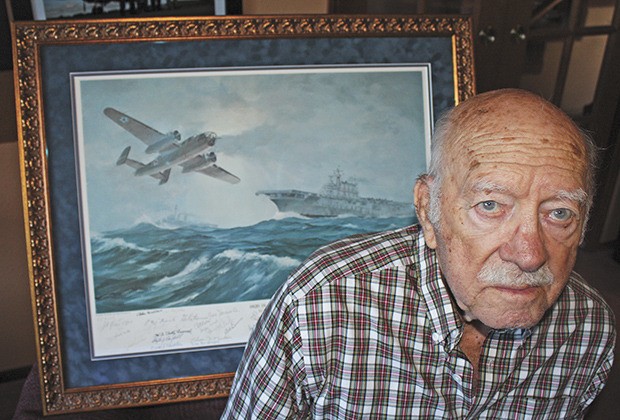It was daring, difficult and dangerous – a mission like no other.
Military historians claim the Doolittle Raid on April 18, 1942 changed the course of World War II in the Pacific.
Edward Saylor was there, one of 80 volunteer crewmen who defied the odds by pulling off the surprise bombing raid of the Japanese homeland.
Such a feat did much to steady a nation still reeling from Japan’s devastating attack on Pearl Harbor on Dec. 7, 1941. The United States’ retaliatory, daylight strike proved Japan’s vulnerability and provided a vital morale boost for a resilient nation thrown into battle.
“Some say we changed the course of the war. I guess we probably did, to some degree,” said Saylor, of Enumclaw, at 93, one of only four original “Raiders” living today. “We did what we had to do.”
Saylor, a sergeant flight engineer on plane No. 15, known as “TNT,” shares his story of duty, survival and honor at 7 p.m. Tuesday at the Auburn Avenue Theater, 10 Auburn Ave. The free program is part of the City of Auburn’s Veterans Day Observance, a prelude to Saturday’s parade down Main Street.
Saylor, who grew up on a cattle ranch in Montana, enlisted in the U.S. Army Air Forces to learn a trade and to serve his country.
The call of duty lured the young airman to volunteer for a special mission designed by Lt. Col. James “Jimmy” Doolittle.
“We didn’t know what it was all about. We had no idea,” Saylor said. “We thought probably we were going to go some place where there were short runways to fight the war … but it turned out to be Japan.”
Saylor soon discovered it would be a dangerous flight, a daylight raid without an escort.
“I didn’t expect to survive the mission. The odds were too great,” he said. “The more I think about it, the more amazing it becomes. At the time, we were well trained … the war was on. It’s just what you do. … We went into the front door of the enemy.”
Saylor was aboard one of 16 twin-engined B-25 Mitchell bombers that launched from the flight deck of the USS Hornet, climbing into a 30-mph headwind to reach a cruising altitude of just under 1,500 feet over the deep Western Pacific Ocean.
None of the B-25 pilots, including Doolittle, had ever taken off from a carrier.
Crews had just enough fuel to reach their military targets in Japan and continue westward to land in China.
The raid met little resistance, caused negligible material damage, but it succeeded in its goal of helping American morale and casting doubt in Japan on the ability of the Japanese military leaders. It prompted Japan’s military leaders to withdraw the nation’s powerful aircraft carrier force from the Indian Ocean to defend their home islands. The raid also contributed to Admiral Isoroku Yamamoto’s decision to attack Midway in the Central Pacific, where the U.S. Navy routed the Imperial Japanese Navy.
After the attack, the bombers, running low on fuel and facing deteriorating weather, tried to reach intended bases in China. Fifteen aircraft made it to the Chinese coast, where their crews crash landed or bailed out. One crew flew to the Soviet Union.
All but three of the crew survived, but the aircraft were lost. The Japanese Army captured eight crewmen in China and executed three.
Thirteen entire crews, and all but one crewman of a 14th, returned either to the United States or to American forces.
Saylor was one of the survivors. He survived a splash landing along the China coast, avoided capture and hitch-hiked westward to West Africa, where he found his way back home.
He and his wife, Lorraine, were married for 69 years before her passing several years ago. They raised three children.
Saylor made the military his career. He retired in Tacoma a lieutenant colonel after 28 years with the Air Corps and its successor, the Air Force.
“It was an obligation,” he said of his service. “(Looking back) I’ve had good luck and a good life.”



